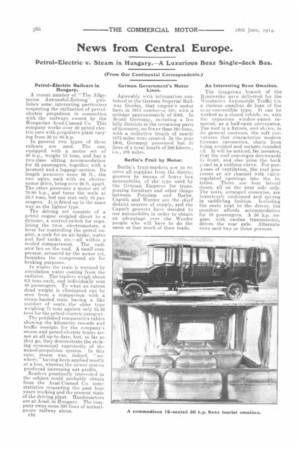News from Central Europe.
Page 16

If you've noticed an error in this article please click here to report it so we can fix it.
Petrol-Electric v. Steam in Hungary.--A Luxurious Benz Single-deck Bus.
(From Our Continental Correspondents.) Petrol-Electric Railcars in Hungary.
A recent number of " The AlIgen-mine ..kutoruabil-Zeitung" publishes some interesting particulars respecting the utilization of petrolelectric propulsion in connection with the railways owned by the Hungarian Arad-Csanad Co. This company works over 40 petrol-electric cars with propulsive plant varying from 30 to 80 h.p.
In general two types of these railcars are used. The one, equipped with a motor set of 40 h.p., weighs 13 tons, and has a two-class sitting accommodation for 42 passengers, together with a lavatory and a luggage-section. Its length measures some 39 ft., the two axles, each with an electromotor drive, being over 26 ft. apart. The other possesses a motor set of 70-80 h.p., and turns the scale at 16.3 tons, but can seat only 40 passengers. It is fitted up in the same way as the lighter type. The driving set consists of a petrol engine coupled direct to a dynamo, a control-switch for regulating the twin electromotors, a lever for controlling the petrol engine, a cock for an air-brake, water and fuel tanks, etc.—all within a roofed compartment. The radiator lies on the roof. A small compressor, actuated by the motor set, furnishes the compressed air for braking purposes. In winter the train is warmed by circulation water coming from the radiator. The trailers weigh about 6.3 tons each, and individually seat 48 passengers. To what an extent dead weight is eliminated can be seen from a comparison with a steam-hauled train having a like number of seats, the older type weighing 73 tons against only 35.26 tons for the petrol-electric category. The published comparative tables showing the kilometre records and traffic receipts for the company's steam and petrol-electric trains are not at all up-to-date, but, so far as they go, they demonstrate the striking economical superiority of the mixed-propulsion system. In this case, steam was, indeed, '.' nowhere," having been applied mostly at a loss, whereas the newer system produced increasing net profits.
Readers practically interested in the subject could probably obtain from the Arad-Csanad Co. some statistics respecting the past four. years working and the present state of the driving plant. Headquarters are at Arad, in Hungary. The company owns some 300 lines of normalgauge railway alone.
n16 German Government's Motor Lines.
Agreeably with information contaided in the German Imperial Railway Guides, that empire's motor lines in 1913 numbered .340, with a mileage approximately of 3062. In South Germany, including a few hilly districts in the remaining parts of Germany, no fewer than 190 lines, with a collective length of nearly 1875 miles were created. In the year 1906, Germany possessed but 20 lines of a total length of 296 kiloms., i.e., 185 miles.
Berlin's Fruit by Motor.
Berlin's fruit-markets are to receive all supplies from the district growers by means of heavy box automobiles, of the type used by the German Emperor for transporting furniture and other things between Potsdam and Berlin. Caputh and Werder are the chief district sources of supply, and the Caputh growers have decided to use automobiles in order to obtain an advantage over the Vilerder people who will have to do the same or lose much of their trade. An Interesting Benz Omnibus.
The Gaggenau branch of the Benzwerke have delivered for the Wiesbaden Automobile Traffic Co. a curious omnibus de luxe of the sent-convertible type.. It can be worked as a closed vehicle, or, with the capacious window-panes removed, as a half-open conveyance. The roof is a fixture, and shews, in its general contours, the soft curvatures that characterize modern German carosseries, sharp lines being avoided and corners rounded cif. It will be noticed, for instance, that the roof converges downwards in front, and also joins the back panel in a uniform curve. For purposes of ventilation, the roof possesses an air channel with valveregulated openings into the interior. There are four lateral doors, all on the near side only. The seats, arranged crosswise, are luxuriously cushioned and sprung in saddlebag fashion. Including the seats next to the driver, the omnibus affords accommodation for 16 passengers. A 50 h.p. engine, with cardan transmission, drives the rear axle. Alternate rows seat two or three persons.
























